
Mitsubishi's forgotten off-road Evo supercar
Have you watched the Budget 4WD Off-Road Adventure (CLICK HERE) yet? If not you're missing out on nearly 40-minutes of awesome dirt-chuckin' action in Marty's bargain Mitsubishi Delica off-road van. While we love cheap Japanese 4x4s some of us prefer our dirt-going rides to have a bit more handling and braking, and a lot more choo-choo so, in the interests of balance, here is an off-road Mitsubishi you may not know about: the RVR Hyper Sports Gear R!
Launched in February of 1991 the Mitsubishi RVR was available as a basic naturally aspirated front-wheel-drive or all-wheel-drive hatch... and a gnarly little automotive bulldog called the Hyper Sports Gear R. To transform it into said Hyper Sports-and-so-on-and-so-forth Mitsubishi took the drivetrain from a little car called the Galant VR-4.

While it doesn't look like much in its civilian trim, this was Mitsubishi's "Evo Zero". Packing the formidable DOHC two-litre turbocharged 4G63, a slick five-speed manual, all-wheel-drive grip and limpet-like handling, the HH-series VR-4 fired the first shots in Mitsubishi's 90s turbo performance era.
Its plain Jane looks have helped keep it a cult classic today, and clean examples are highly prized.

Here is a Galant in more recognisable trim, running in the Group A class of the World Rally Championship. It took the three-pointed-diamond's fight up to the Subaru Legacy RS, Ford Escort Cosworth, Lancia Delta Integrale, Mazda Familiar GT-R and Nissan Pulsar GTi-R in Group A rallying, providing some epic footage in the hands of Aussie legends Ross Dunkerton and Ed Ordynski.
Mitsubishi stopped short of packing all the Group A hardware into the RVR, however. They moved a few packaging issues for the 4G63 around (like changing from a front-mount intercooler to a top-mount) and this meant the spicy mid-size MPV RVR (LOL) wound up producing between 170kW and 184kW depending on the year/specs.

You can see the differences in the RVR engine bay below. Keeping the front of their off-road beastie free of an intercooler lessened the risk of trail-side stoppages should a rock or stick pierce the charge air cooler.

The turbo model scored a chunky bodykit which helped push the dimensions out to a nuggety 1695-wide, which is chunky considering it was only 4480mm-long and 1625mm high. For its short length the wheelbase was comparatively generous at 2550mm helping accentuate the stout dimensions.
The RVR's performance capabilities did cop a knock with Mitsubishi choosing to fit them with open diffs at the front and back, instead of sweet, skiddy limited-slip jobbies. But there were aftermarket solutions for those problems in years gone by.

Because most Ralliart fans head straight for Evos or Galants the RVR has spent decades living in the shadows of its more-famous siblings and, when they started being imported to Australia in the late 90s, few gave them a second look. However, they have developed a real cult following as a budget all-wheel-drive performance car.
They have a small following in Japan, as evidenced by the tuned-up example posted below which I found on Google. There was also a red-hot example in Queensland 15 years ago running nines at the drags with a stroker 2.2-ltire engine.

So next time you're looking for an off-road machine that you could also take to the traffic light grand prix, have a look around for a Mitsubishi RVR Hyper Sports Gear R. They may not be common or as spacious as the Delica, but they'll be an absolute hoot to drive.


![Limited Edition Budget Street Cred Golf Poster [AUTOGRAPHED]](http://mightycarmods.com/cdn/shop/files/FullSizeRender_480x480.jpg?v=1760910149)
![Boosty Boi T-Shirt [Black Edition]](http://mightycarmods.com/cdn/shop/files/DSC2662_b504777a-ecdc-4da2-8b18-b4b525bce4d5_480x480.jpg?v=1759355323)
![Chopped MCM Hoodie [Black Edition]](http://mightycarmods.com/cdn/shop/files/DSC2445_d41795ae-8f15-4257-8ae2-60623a893824_480x480.jpg?v=1759099951)
